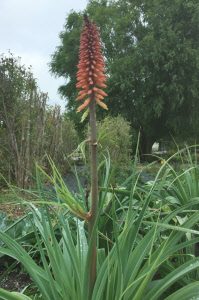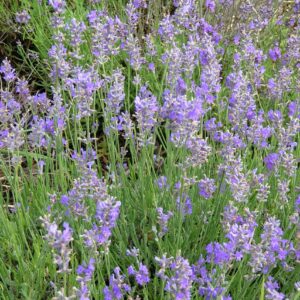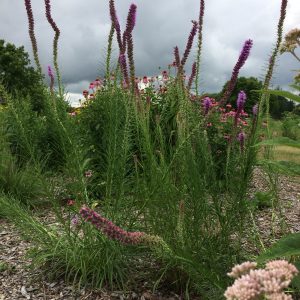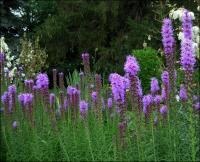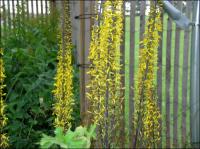Deer Resistant Plants
Showing 81–88 of 163 results
-
Kniphofia caulescens Red hot poker, Regal torch lily Z 5-10
fat spikes of flowers open coral-red, turning pale lemon-yellow
Evergreen perennial with short, stout stems bearing grass-like broad, grey-green leaves. Blooming July to August, fat spikes of flowers open coral-red, turning pale lemon-yellow
Size: 3’ x 2-3’
Care: sun in moist well-drained soil
Native: Lesotho South Africa
Wildlife Value: deer and rabbit resistant. Attracts hummingbirds
Awards: Royal Horticultural Society Award of Garden Merit; Denver Botanic Garden Plant SelectIntroduced to gardens by Mr. T. Cooper about 1860. 1st described by French botanist Carrière in Revue Horticole in 1884
-
Kniphofia triangularis Dwarf Red hot poker Z 5-8
From early to late summer, with dead-heading, vivid coral spikes, like a torch .
From early to late summer, with dead-heading, vivid coral spikes, like a torch. This plant has everything- resistant to deer & rabbits, long blooming, great cut flowers, hummingbirds and butterflies love it.
Size: 2’ x 12-18”
Care: sun in moist to well-drained soil, Drought tolerant once established
Native: mountain grassland & moist areas in the Eastern Cape to the Northern province of South Africa.
Wildlife Value: resistant to deer & rabbits, hummingbirds and butterflies love it.1st described in 1854 in Enumeratio Plantarum Omnium Hucusque Cognitarum, Vol. 4 p. 551
-
Lavandula angustifolia ‘Munstead’ Z 5-9
Very fragrant, compact form of Lavender blooms in wands July-September.
Very fragrant, compact form of Lavender blooms in wands July-September.
Size: 12-18” x 12-18”
Care: Sun, well-drained, soil. Prune to 8” in spring every 2 years to control plant size and promote new growth.
Native: species native to Western Mediterranean
Wildlife Value: Attracts many different bee species and butterflies. Resistant to rabbits and deerThis selection introduced to gardens in 1916. Named for Munstead Woods in England, the home of the extraordinary garden designer Gertrude Jekyll (1843-1932) Lavandula is Latin from lavare meaning “to wash” because it was thrown into baths for the scent, “or because used in lye to give a fragrancy to linen; and because it is very good to wash the face with, and give it both beauty and a grateful scent.”
-
Liatris pycnostachya Prairie blazing star Z 3-9
Tall, erect, purplish- pink spike in August-September
OUT OF STOCK
Tall, erect, purplish- pink spike in August-September
Size: 4’ x 1-2’
Care: well-drained soil in full sun
Native: central & SE US
Wildlife Value: deer resistant, attracts birds, butterflies, and beesCollected by French planthunter Andre Michaux in 1795 on the prairies of Illinois. About 9 years later collected on the Lewis & Clark Expedition in South Dakota September 1804
-
Liatris spicata Blazing star, Gayfeather, Button snakeroot Z 3-8
Rosy purple spikes in July and August, a flower arranger’s dream
Rosy purple spikes in July and August, a flower arranger’s dream
Size: 2-3' x 18"
Care: Full sun in moist to well-drained soil.
Native: Eastern and southern U. S., Wisconsin native
Wildlife Value: favorite nectar source for Buckeye butterflies & host for caterpillars of Painted lady, Fritillaries, Skippers, Sulphurs, Coppers & Checkerspot butterflies.Native Americans used roots medicinally for backaches, colic, dropsy and to strengthen a weak heart. The Dakota recognized L. spicata as an indication “when the flower is blue-red that corn is good to eat.” Nicollet Diary, August 13, 1838. The dried root reputedly repelled moths from stored clothes. First collected by English naturalist Mark Catesby (1683-1749) and cultivated since 1732. Grown at America’s 1st botanic garden, Elgin Botanic Garden 1811.
-
Ligularia przewalskii syn. Senecio przewalskii Leopard plant Z 4-8
Bold, deeply palmate lobed foliage, deep yellow spike in late summer
Bold, deeply palmate lobed foliage, deep yellow spike in late summer
Size: 5-6' x 24-36"
Care: full to part shade in moist soil.
Native: Northern ChinaNamed for Nikolai Przewalski (1839-1888), Polish geographer and naturalist who explored Central Asia on behalf of Russia. First described in Bulletin de l’Academie Imperiale des Sciences de St-Petersburg, sér. 3 26(3): 493. 1880.
-
Ligularia stenocephala Leopard plant Z 4-8
Daisy-shaped buttercup to golden yellow flowers cover narrow, 4-5 ‘tall spikes from late summer to early fall. Its foliage is as arresting as the flowers. Big, rounded-triangular shaped leaves with sharply scissored edges surround the bottom with smaller ones cover the stems until the leaves meet the bottoms of the flower spike.
Daisy-shaped buttercup to golden yellow flowers cover narrow, 4-5 ‘tall spikes from late summer to early fall. Its foliage is as arresting as the flowers. Big, rounded-triangular shaped leaves with sharply scissored edges surround the bottom with smaller ones cover the stems until the leaves meet the bottoms of the flower spike.
Size: 5’ x 5’
Care: part shade in moist soil
Native: China, Taiwan, and Japan
Wildlife Value: a favorite nectar and pollen source for bees and butterflies. Rabbit resistantCollected and first named by Russian botanist Carl Johann Maximowicz (1827 – 1891). St. Peterburg Botanic Garden sent him to South America where he searched for plants around Rio, then crossing Cape Horn he collected in Hawaii. After his ship was commandeered off the coast of China, he crossed China from west to east through China and Siberia recording his specimens that grew along the Amur River. He returned traveling west to east then crossed the East China Sea of the Pacific Ocean to Japan where he collected for four years.
-
Limonium latifolium syn. Limonium platyphyllum Sea lavender, Statice latifolia Z 2-8
Airy lavender blue panicles from mid to late summer. Leathery foliage turns reddish in fall. Excellent cut or dried flowers.
OOS
Airy lavender blue panicles from mid to late summer. Leathery foliage turns reddish in fall. Excellent cut or dried flowers.
Size: 24-30” x 24”
Care: Full sun in well-drained soil
Native: Russia, Bulgaria & Romania
Wildlife Value: Deer resistant.Limonium is Greek meaning “meadow” and latifolium means “wide leaf”. This was identified by Dioscorides in De Materica Medica for medicinal use around 70 A.D. Cultivated in gardens since 1700’s. Formerly used to repel moths and cure canker sores.

